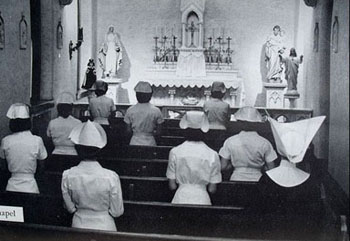A Hospital Transformed
November 4, 2013

NEXT YEAR, the order of religious sisters known as the Daughters of Charity will permanently sever their ties with St. Thomas Hospital in Nashville, an institution which they opened more than 100 years ago. At Tradition in Action, Marian T. Horvat describes how the liberalism of Vatican II effaced the religious order and gradually transformed the Catholic hospital, once under the capable management of women who took vows of lifelong poverty and charity, into a modern secular institution run by bureaucrats. Dr. Horvat writes:
The competence, energy and expertise of the nursing Daughters of Charity made them much in demand. But it was something more that won them the love and devotion of the people they served. In their distinctive grey habit with the white cornette, these sisters embodied lives of sacrifice. They received no personal salaries, they renounced the social amenities and feminine vanities of the world – all with the aim of serving Christ and seeing Him in the suffering sick of humanity. Such a noble mission reflected in the demeanor and person of each sister, who became a symbol of the model selfless nurse.
After Vatican II, however, things started to change. No more triangular white cornettes were seen in the hospital halls. The Sisters now were in modified habits or secular dress. Soon, the vocations started to diminish and the School of Nursing closed.
In 1975 the old St. Thomas Hospital was torn down to make way for a parking lot and the current thoroughly modern institution opened on Harding Road. Then, following the general trend in hospital administration, St. Thomas Hospital became a part of St. Thomas Health, a conglomerate of hospitals of different denominations and a network of affiliated clinics, services and rehabilitation facilities.
Finally, in 2002, St. Thomas and Baptist Hospitals merged as St. Thomas Health. Like so many other hospitals, St. Thomas no longer calls itself Catholic, but rather “a faith based ministry.”
The Sisters who remained were professionals, dressed for a time in modified habits and finally just in lay clothing. The traditional vows of the Daughters of Charity were redefined for the 21st century: for example, the vow of obedience was replaced by an ambiguous vow of dependence, and the vow of poverty practically disappeared when the sisters began to have budgets and spending money to use as they pleased. The vow of obedience was considered obsolete, a remnant of a hierarchical world of rulers and underlings.
— Comments —
Hannon writes:
I was reminded by your post of a related disintegration in another community. St. Francis Hospital was a well-known and beloved landmark in Santa Barbara, California, that has all but vanished in recent years (literally). It was beautiful (photos here and here) and perched on Santa Barbara’s “Riviera” it was provisioned with commanding views of a famously scenic city.
I noticed in the first link a similar case of Catholic diaspora for the nurses and others formerly associated with the hospital and the dreary “inter-faith” meme that is universal these days. The former site of St. Francis Hospital will now go to over 100 housing units in an already over-crowded city.
When I was very young I had a stay or two both at St. Francis and at Cottage Hospital, the corporate, secular alternative with modern steel and glass construction instead of stucco and red tile roofs. The difference in personal care from the staff, by my recollection, was in accord with the architectural differences: one cold and impersonal, the other notably warm and caring. Cottage is also in a rather dark setting surrounded by large trees with sterile landscaping and no views to speak of. The contrast was obviously memorable.
Perhaps I am overly nostalgic for very special kinds of places like St. Francis, with memories bound to childhood impressionableness. But in my young thinking I held St. Francis to be a standard because of the way its staff and even the architecture itself made me feel. This standard has been replaced by a corporate model that is racing in the opposite direction, away from humanity and caring even as it maintains a vigorous allegiance to medicine.
A reader writes:
Hasn’t much the same secularization happened with Catholic schools?
Laura writes:
Yes.
Daniel writes:
I’d like to point out what happened to my old Catholic elementary school some years after I left.
I went there from 1987-1991. Although the late 80s and early 90s could hardly be called a Golden Age, it still had the remnant of pre-Vatican II strictness, especially with teachers and the Brothers and Sisters who taught several of the classes. Although I am not universally in favor of uniforms (but rather a strict dress code instead), everyone including teachers was well dressed and behaved. I can’t ever remember a fight or trouble with any student. The church’s exterior was disgustingly modern, but inside it was quite tasteful and had a memorable altar.
But if you look at the place now, there is very little mention of the Catholicity of the place. It being in Maryland not far from DC, nearly all (or entirely all?) of the student body is black. When I went there, there were under 10 black students, but now it is basically a black school. The plays that they put on are no longer either Catholic or harmless secular plays, but plays that are catered to black interests. Obviously, there is nothing wrong with blacks in the Catholic church. But I am not convinced that is what happened here. Looking at the school program, I dont see ‘Religion’ as a subject taught to all students. Instead of the blacks becoming Catholic, it appears the Catholic school became black.
A reader writes:
Long ago I read interviews in which people said they owed their success to the Catholic schools they attended. I wonder if the younger generation will say the same.

